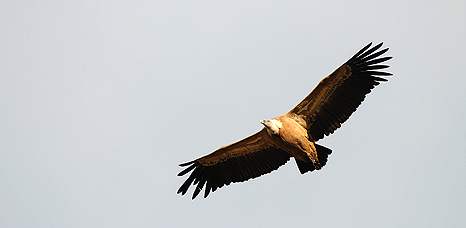Helen Bell travelled on our 'Spain - Extremadura in Winter' holiday and submitted this entry to our writing competition.
Griffon Vulture by David Morris
The ancient plains of Spain's Extremadura are punctuated here and there by rocky outcrops, some of them crowned with castles built by earth-bound humans in mediaeval times, anxious to survey the plains for the approach of their enemies.
But the mighty tower of Penafalcon thrusts up from the sullen River Tajo with no such human adornment. In the murky waters at its feet, otters play, but its flanks are the home of griffon vultures. They survey their domain from the air, and have no need for tall vantage points, but they must nest on something solid, and use the haven of Penafalcon to rear their chicks.
There is a viewing point opposite Penafalcon, and when we arrive and set up our scopes, our eyes are drawn initially to the few vultures circling overhead. Soon someone says 'there's one on the rock', and we realise that it is festooned with vultures: some on scrappy looking nests, some just loafing, and some on the skyline. They look hulking and clumsy, and we can hear their harsh cries when they argue at the nests. As the sun warms the rock, invisible thermals of air start to rise, and gradually the blue southern sky fills with the black silhouettes of vultures circling round and round, seemingly in slow motion, lifting away from Penafalcon, a kaleidoscope of black and blue. They seem to be randomly distributed, but then I notice that a few are flying in formation. A group of four, flying in a diamond shape, appear over the side of the rock, holding the formation for a minute, then gradually breaking up. Then another group in a triangle shape, and then I see two flying one above the other, with what appears to be a mere hand-breadth of blue air between them. Why are they doing this? No doubt a biologist would invoke some explanation involving the passing on of genes, which may well be true, but I feel that the birds are revelling in their mastery of the air, as humans might revel in running and jumping.
Someone has found a blue rock thrush and soon we have all had good scope views of this obliging little bird. For a bird with the power of flight, he seems remarkably earth-bound, a little piece of blue among the darkness of the rocks which he makes his home. He poses in classic blue rock thrush style, only his head and shoulders showing above the rock, beak pointing up to the sky where the vultures circle endlessly.
Then, a black wheatear, unexpected here, flitting and perching just below us. A neat, dapper little bird, all in black except for the white pattern in his tail which announces his kinship with other wheatears. His mere presence delights us, amply making up for a black wheatear 'no show' on a previous day.
We leave the site with contrasting mind's eye pictures: the magnificent broad canvas of the rock, stark against the sky with the ever present vultures, and the exquisite miniature of the black wheatear, every feather detailed, small and transient.
Once again, nature has awed, inspired, and delighted.
Read more about our 'Spain - Extremadura in Winter' holiday.



 Loading search...
Loading search...
